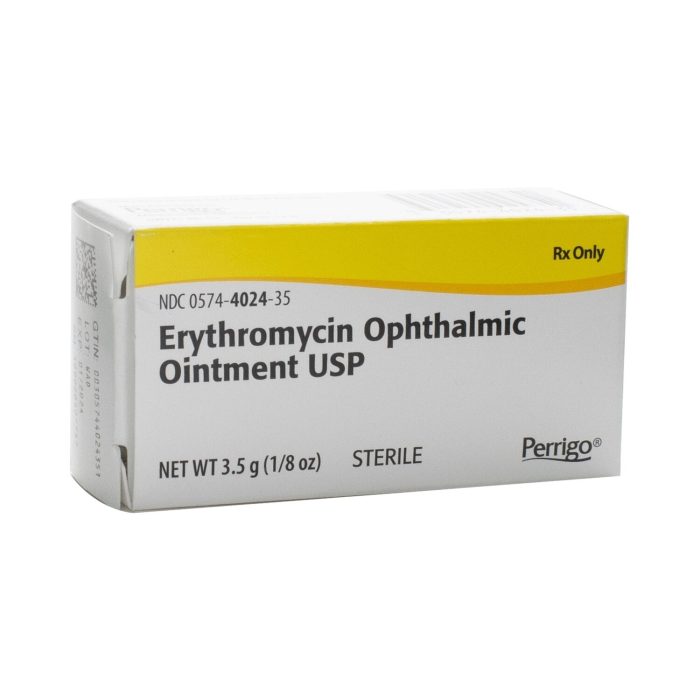Erythromycin ophthalmic ointment is a common topical antibiotic used to treat bacterial infections of the eye. This ointment contains erythromycin, a macrolide antibiotic that works by inhibiting the growth of bacteria. It is commonly prescribed for conditions like conjunctivitis (pink eye), blepharitis (inflammation of the eyelids), and bacterial keratitis (inflammation of the cornea).
Applying the ointment is simple, typically done by gently pulling down the lower eyelid and placing a thin ribbon of ointment inside the conjunctival sac. The frequency of application depends on the severity of the infection and the doctor’s instructions. While generally safe and effective, potential side effects such as eye irritation, redness, and allergic reactions can occur. It is crucial to follow your doctor’s advice, adhere to the prescribed dosage, and inform them about any other medications or supplements you are taking.
Erythromycin Ophthalmic Ointment

Erythromycin ophthalmic ointment is a topical antibiotic used to treat bacterial infections of the eye. It is available over-the-counter (OTC) and by prescription.
Purpose and Mechanism of Action
Erythromycin ophthalmic ointment is used to treat bacterial infections of the eye, such as conjunctivitis (pink eye). It works by killing or stopping the growth of bacteria. Erythromycin belongs to a class of antibiotics called macrolides. It works by preventing bacteria from producing essential proteins that are needed for their survival. This process is called protein synthesis inhibition.
Common Conditions Treated
Erythromycin ophthalmic ointment is commonly used to treat the following conditions:
- Conjunctivitis (pink eye) caused by bacteria
- Blepharitis (inflammation of the eyelids)
- Keratitis (inflammation of the cornea)
- Trachoma (a chronic bacterial infection of the eye)
Usage and Administration
Erythromycin ophthalmic ointment is typically applied to the affected eye(s) as directed by your doctor. It’s crucial to follow your doctor’s instructions carefully, as the frequency and duration of treatment may vary depending on the condition being treated.
Applying the Ointment, Erythromycin ophthalmic ointment
Applying erythromycin ophthalmic ointment is a simple process. Here are the steps:
- Wash your hands thoroughly with soap and water before applying the ointment.
- Tilt your head back and gently pull down your lower eyelid to create a pouch.
- Squeeze a thin ribbon of ointment into the pouch.
- Close your eye gently and move your eye around to distribute the ointment.
- Wipe away any excess ointment from your eyelashes and eyelids.
- Repeat these steps for the other eye, if necessary.
Frequency of Application
The frequency of application will depend on the specific condition being treated. For example, for bacterial conjunctivitis, the ointment is typically applied every 4 hours, while for prophylaxis against ophthalmia neonatorum, it is applied once after birth.
Importance of Following Prescribed Dosage
It is essential to follow your doctor’s instructions regarding the frequency and duration of treatment. Using the ointment more often or for a longer period than prescribed may increase the risk of side effects. On the other hand, using it less often or for a shorter period than prescribed may not be effective in treating your condition.
Potential Side Effects: Erythromycin Ophthalmic Ointment

Like any medication, erythromycin ophthalmic ointment can cause side effects. These are usually mild and temporary, but some can be serious. It’s important to be aware of the potential side effects and to contact your doctor if you experience any concerning symptoms.
Common Side Effects
Common side effects of erythromycin ophthalmic ointment are usually mild and may include:
- Burning
- Stinging
- Itching
- Redness
- Temporary blurring of vision
These side effects typically resolve on their own within a few days. If they persist or worsen, consult your doctor.
Rare but Serious Side Effects
While rare, some serious side effects can occur with erythromycin ophthalmic ointment. These include:
- Allergic reactions, which can be severe and potentially life-threatening.
- Eye irritation, which can be severe and persistent.
- Eye pain, which can be a sign of a more serious problem.
- Changes in vision, which can be a sign of a serious eye condition.
If you experience any of these serious side effects, stop using the ointment and contact your doctor immediately.
Allergic Reactions
Allergic reactions to erythromycin ophthalmic ointment can occur. Symptoms of an allergic reaction may include:
- Swelling of the eyelids, face, lips, or tongue
- Difficulty breathing
- Hives
- Rash
- Itching
If you experience any of these symptoms, seek medical attention immediately. Allergic reactions can be life-threatening, so prompt treatment is essential.
Erythromycin ophthalmic ointment remains a valuable tool in the fight against bacterial eye infections. Understanding its uses, potential side effects, and precautions is essential for safe and effective treatment. Always consult with your healthcare provider to determine if erythromycin ophthalmic ointment is the right treatment option for you.
Erythromycin ophthalmic ointment is a common treatment for bacterial conjunctivitis, often known as pink eye. While it targets bacteria, it’s important to remember that the underlying cause of the infection can vary. For example, a condition like depression, which may be treated with medications like SNRIs , can sometimes weaken the immune system, making individuals more susceptible to infections like pink eye.
Therefore, treating the underlying condition alongside the infection is often crucial for a complete recovery.